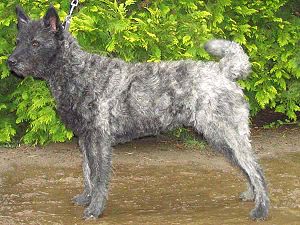Hollandse Herdershond
| Hollandse Herdershond | |||||||
|---|---|---|---|---|---|---|---|
|
|||||||
| FCI Standard No. 223 | |||||||
|
|||||||
| Origin : | |||||||
| Alternative names: |
Dutch Shepherd Dog, Herder |
||||||
| Withers height: |
Males: 57-62 cm. |
||||||
| Varieties : |
Shorthair, longhair, wire-haired |
||||||
| Breeding standards: | |||||||
| List of domestic dogs | |||||||
The Hollandse Herdershond (Dutch Shepherd Dog) is a Dutch breed of dog recognized by the FCI ( FCI Group 1, Section 1, Standard No. 223 ). He has been listed by the AKC for possible recognition in the Foundation Stock Service since April 2012 , he has been recognized since January 1, 2017 and he belongs to the Miscellaneous Class .
Origin and history
The Hollandse Herdershond has common roots with the Belgian Shepherd , both breeds come from the same region. After Belgium separated from the Netherlands in the 19th century, the border also divided the previously uniform working dog population without changing it significantly, as the demands on the dogs remained the same. The Hollandse Herder was not recognized by the FCI until 1960. Nowadays the Dutch breed is very rare. In Germany, 54 puppies were littered in 2007, after around 30 to 40 puppies in the previous years.
description
The height at the withers is up to 62 cm with a weight of approx. 30 kg (males). Different coat variations are bred: short-haired (own stick hair), long-haired (long-stick hair), rough-haired. Short- and long-haired herders are gold and silver brindle - from very light to medium to very dark. In addition to gold and silver brindle, wire-haired people are also blue-gray or pepper and salt-colored. The dogs' ears are large and erect, and very flexible.
Essence
The breed association describes the Hollandse Herdershond as affectionate, obedient, vigilant, eager to work, undemanding, of great perseverance, always attentive, active and “endowed with the characteristics of a real German Shepherd”.
Compared to the Belgian Shepherd Dog, the breed is said to be more tolerant towards fellow dogs. He shares his sensitivity with the Belgian, and he cannot stand a hard hand.
The three varieties are said to have a different character, also with a parallel to the Belgian Shepherd Dog: the short-haired variant is seen as more "instinctive" and therefore more suitable for protective work, the long and rough-haired strokes should be friendlier, calmer and more compatible with one another be. What all three varieties have in common is the joy of dog sport or rescue work, whereby the long-haired Dutch Shepherd Dog is rarely found in protection dog sport.
use
Protection dog , assistance dog , dog sports , herding dog , rescue dog , police dog , therapy dog
Legal position
The Dutch Shepherd Dog is on the breed list of potentially dangerous dog breeds in the Swiss canton of Ticino , and keeping them there requires a permit.
Individual evidence
- ^ Dutch Shepherd on the AKC website
- ↑ AKC: FSS News & Updates 01/11/16
- ↑ puppy statistics of the VDH
- ↑ Official homepage of the Dutch Shepherd Club Germany eV
- ↑ Official homepage of the Swiss Club of Dutch Shepherds / Breeding


